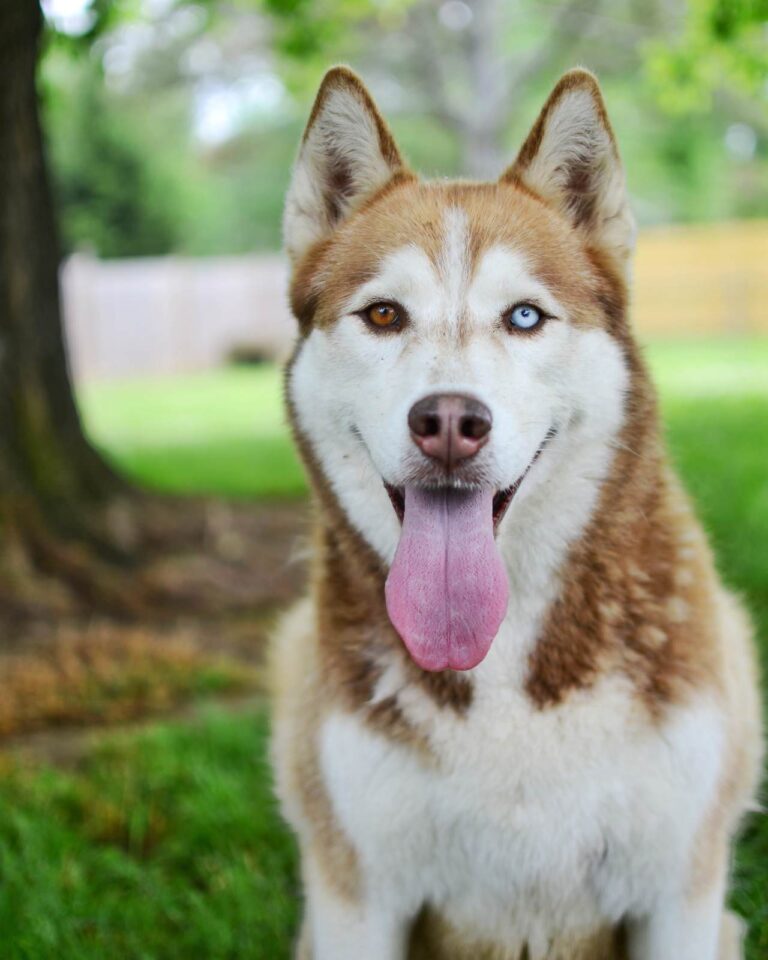Masticatory Myositis
WHAT IS MASTICATORY MYOSITIS?
Masticatory myositis (MM) is a disease that causes an inability to open the mouth. Other names for this are Masticatory Muscle Myositis, MM, Trismus or Triple M. German Shepherds, Labrador Retrievers, Golden Retrievers, Doberman Pinschers, and Cavalier King Charles Spaniels are the most commonly affected breeds, but any breed or mix can be affected. MM is an autoimmune disease wherein the immune system attacks special muscle fibers (called 2M fibers) within the muscles that work to chew and close the mouth, specifically the temporal, masseter and pterygoid muscles. At first, the muscles swell as a result of this immune attack, which can be quite painful. However, over a short period of time, the muscles start to thin and waste away due to internal scarring.
Dogs with masticatory myositis have a progressive inability to open their mouths, beginning with a mildly decreased range of motion but ending with a complete inability to open the mouth. Early on, some dogs will have signs of pain such as crying out when opening the mouth, decreased appetite, slow eating, or shying away from petting. People often note that their ball-obsessed dogs will no longer play with their favorite toys. Sometimes one might see visible swelling of the muscles of the head and a bulging/’bug-eyed’ appearance to one or both eyes. Over time, however, the muscles scar down and waste away which causes a change in appearance where the eyes may appear sunken and the shape of the head changes (in the fuzzy/furry dogs, this might not be noticed). Over time, the scarred muscles will prevent any ability to open the mouth and the dog will be unable to eat or drink.
HOW IS MASTICATORY MYOSITIS DIAGNOSED?
There are several pathways to the diagnosis of masticatory myositis:
- Clinical signs:
- Wasting away of the muscles around the head- in short-haired dogs, this can be extremely prominent and obvious on visual inspection
- Crying out when trying to open the mouth or reluctance/inability to eat or chew bones/treats
- Lethargy, reluctance to play
- Blood tests
- 2M antibody titre test
- This test measures the level of the antibodies that attack the muscle fibers. If positive, this test is highly accurate for disease. However, false negatives are common. I.e., if your dog has a negative blood test result, he/she can still be affected by the disease. This is especially true if your dog has been affected with the disease for a longer period of time prior to testing and/or has been treated with steroids prior to testing.
- 2M antibody titre test
- Imaging (CT scan)
- A CT scan is important to rule-out any other factors that might cause a dog to have difficulty opening the mouth. A CT scan looks at the anatomy of the TMJ joints as well as the health of the muscle and other structures of the head.
- Muscle Biopsy
- This is the gold standard test to diagnose MM. To do this, an incision is made over the muscles on the top of the head (generally we biopsy the temporal muscles). Two to three small samples are then collected and sent to a lab that specializes in the diagnosis of this disease. This test, in conjunction with a CT scan, will give a definitive answer as to whether a dog is truly affected with this disease.
HOW IS MASTICATORY MYOSITIS TREATED?
Treatment for masticatory myositis involves immunosuppressive medications (medications that stop the immune system from attacking normal tissue). Prednisone is the most common first line treatment chosen as it is very effective as a sole treatment. Most dogs will have an increase range of motion with their mouths within 1-3 days of starting treatment. About 90% of dogs will regain a normal ability to open their mouths within 2-3 months of treatment. About 25% of dogs will experience relapse at some point; younger dogs and dogs with more severe fibrosis on biopsy are more likely to experience a relapse. If no relapse is seen within13 months of the original diagnosis, a relapse is unlikely.
Generally, dogs require at least 6-12 months of therapy, and some may need lifelong therapy. Steroid side effects (increased drinking, urinating, panting and appetite, worsening of heart disease, or development of diabetes) may require earlier taper of steroids or adding in an additional medication such as azathioprine or cyclosporine. Increased drinking/urination and panting may be less tolerable in larger dogs.
WHAT CAN I EXPECT WITH TREATMENT?
When your dog is first diagnosed and treated, they may only be able to open their mouths a centimeter or two. This may require some changes at home. Many of these dogs are not able to eat kibble, as they cannot open their mouths wide enough. As such, they may need to eat wet food blended with water to make a gruel consistency. This will increase the amount of water they are intaking with meals, so you may notice a decrease in how much water they seem to drink. Similarly, dogs regulate their temperature via panting. If your dog can’t open its mouth well, it certainly can’t pant well! As a result, it is critical to protect these pets from overheating. Dogs in the early stages of treatment (or before treatment) should have short, leashed walks only, avoiding even moderately warm weather and warm housing conditions.
Most dogs show some improvement within 1-3 days, with peak improvement by 3-4 weeks. Improvement is seen by increased mouth opening with eating and play, and increased interest in mouthing food/items/toys, etc. Forcing the jaws open awake or asleep can cause rupture of the muscle fibers which, in addition to causing pain, can cause further scarring of the muscles, i.e., don’t attempt to open your dog’s mouth forcefully at home.
WHAT IS THE PROGNOSIS?
If your dog is diagnosed with masticatory myositis, they will begin medical treatment. Generally, the prognosis for dogs is good. Earlier diagnosis, earlier therapy, and more aggressive early therapy all improve the likelihood that a full recovery can be made. They should begin to recovery quickly. We often can perform rechecks via phone or email, thus limiting the number of trips into the hospital. Regular updates and communications are critical in making sure that your dog is improving in an expected way. If relapses happen, the sooner we are aware of them, the more likely we are to be able to address them and get the dog back into remission. Though it is a long road of treatment, full recoveries are generally expected.
WHAT ELSE COULD IT BE?
There are many potential causes for an inability to open the mouth. Masticatory myositis does have some hallmark signs, as noted above, but other differential diagnoses could include generalized myositis (affecting all muscles, not just those of mastication), TMJ (temporomandibular joint) disease, retrobulbar disease (masses or infections behind the eye), ulcers in the back of the mouth, or painful growths in the back of the mouth. This wide range of diseases that cause difficulty opening the mouth are one of the many reasons that our diagnostics and work up are important in arriving at our diagnosis of masticatory myositis.
INDY’S STORY:
Indy was a happy, bouncy, typical 3-year-old Labrador Retriever. Her favorite activities were greeting humans, playing with her toys, and her lunchtime treats of ice cubes. One day in July, she was reluctant to eat her ice cubes at lunch. She even cried out when she tried to open her mouth to get them! Shortly thereafter, the right side of her face was swollen. She was not playing with her toys and she was acting abnormally subdued. She was taken to her vet and she had a fever, so she was started on antibiotics and anti-inflammatory pain medications. She seemed slightly less painful, but her reluctance to open her mouth continued to progress. She was then referred to our hospital for further diagnostics and care.
When she first arrived at ADOS, Indy was trying so hard to be her normal sweet self, but it was clear she did not feel well. She was sensitive to us touching around her face (palpation), and she was unable to open her mouth. She was put under anesthesia and luckily her mouth was still able to open enough to place a breathing tube in her airway (which keeps her safe during anesthesia). 3-D bone imaging (cone beam CT) showed that her bones, teeth, and TMJs were healthy. Based on this and her history, a presumptive diagnosis of masticatory myositis was made. In order to obtain a definitive diagnosis, a temporal muscle biopsy and serum antibody testing were performed. Indy was sent home to recover and started on steroids while we awaited results.
Indy improved within days! Despite the fact that she was experiencing some significant steroid side effects (peeing, panting, drinking), she was clearly more comfortable. She was already opening her mouth a bit more and acting more like her normal, happy self. Shortly thereafter, we got her test results which confirmed her diagnosis of MM. Her dedicated parents developed a new routine to manage her side effects and kept up with the steroids. She continued to steadily improve, and within a week or so was already playing with her toys again! By one month, she was essentially normal. After a few weeks we were able to drop her steroid dose a bit, and over the next 9+ months we weaned her down to a very low dose. As of the writing of this, she is off her steroids completely and doing well. We love Indy and are so glad she is able to get back to eating ice cubes, licking new friends, and, importantly, carrying her toys around!







